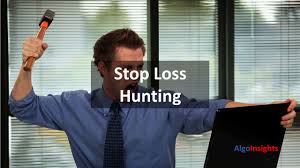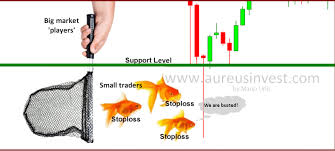Every forex trader known to man has been stopped out before a major move, only to see their positions closed, and then watched as the market did a 180-degree turn, as expected. But someone else benefited from that spike. Our suspicions typically focus on our broker. He is the market maker, after all. He has inventory and insider knowledge of what to expect in the way of fundamental changes, especially in stocks, but in the forex world, such behavior could get the broker in a lot of hot water. In any event, the blame more than likely lies elsewhere, as we will discuss, but how do you mitigate this risk?
The problem with this type of market exchange is that it sticks with you. It does not easily dissipate. You had recognized a pattern in the pricing behavior of your favored currency pair, calculated your risk/reward potential, and then executed your strategy by the book, remembering to place your stop-loss order at the appropriate level where you have been taught in your early training classes. All that you had to do was wait, go to the races, and cash in when the trend had hit your target. The pair suddenly began ranging. It paused, then it dipped 35 pips, clearing out your stop-loss and a host of others, and, after taking a breath, “BAM”, it took off to the north, just as you knew it would.

At this point, you are ready to get physical, like the fellow in the above picture. If a hammer is not readily available, then verbal abuse will have to do. After uttering every demeaning adjective that you can think of and a few others that your Mother would never want to hear, you are ready to close up shop for the day. But wait… we have always been taught that, if you miss a major move in the forex market, do not fret, because there is always another one just around the corner. So what if your broker broke your heart with his stop-loss hunting shenanigans, you will get the better of him next time.
The truth is that you can get better the next time around. Veteran traders have been down this very road more times than they can remember, and instead of getting mad, as the old axiom goes, they got even by developing a new strategy to take advantage of this very familiar pattern in market behavior, whenever firm resistance or support has been noted, tested, and a reversal is in the air. Haven’t we been taught to look for patterns that consistently repeat, and then develop a simple step-by-step strategy to shift the proverbial odds in our favor?
Is someone really to blame for Stop-Loss Hunting (SLH) and why do they do it?
In order to analyze the dynamics of “SLH”, let’s start with simple definition from the Internet: “Stop hunting is a strategy that attempts to force some market participants out of their positions by driving the price of an asset to a level where many individuals have chosen to set their stop-loss orders. The triggering of many stop losses generally leads to high volatility and can present a unique opportunity for investors who seek to trade in this environment.” The second sentence is important. It suggests that there may be an opportunity lurking in this “environment”, and that is what successful trading is all about.
But who is to blame? We are not suggesting that there are not a few shady broker types out there that would resort to such a strategy to profit at your expense, but the vast majority of brokerage houses operate with a regulator looking over their shoulders. Regulators are equipped with monitoring software, designed to detect even a hint of price manipulation in our financial markets, and the small change that a broker could earn from hunting for stops is just not worth it, if the risk of losing its license is on the line.
The “perpetrator”, if we are going to give him that moniker, is more than likely a large institutional trader, that incidentally observed the same pattern, which you had duly noted, forming in the market and then wanted to take advantage of it. These large market players, however, have a continual problem that vexes their every move. Large banks and hedge funds mange portfolios in the hundreds of millions of dollars. When they make a market move, it will be a large one. If volume and liquidity are high, as when a market is trending, then their large order can be absorbed easily, without notice.

The simple “fishing” metaphor portrayed above illustrates what is really happening in a typical SLH situation. The “Big Market Player” anticipates, as you did, that prices are about to bounce off support and head higher, but he also knows that if he sends a large “Buy” order to the market, the price will abruptly escalate, as will his cost entry premium. What does he or she do under these circumstances? The “smart” move is to issue a moderate “Sell” order. The size is one that has been determined over time to deliver the desired result, i.e., jerk the market down enough so that the Big Player can then buy up the abundance of retail stop-loss orders that he knows are lurking just below support.
The result of these buy and sell orders is the familiar candlestick pattern, commonly called the “Hammer” or in some cases a “Dragon Fly Doji”, when opening and closing prices are the same. For those traders familiar with these patterns, they know that they signal a significant reversal to the upside is imminent, usually with the commencement of the next candlestick.
How do you prevent being hunted and take advantage of this situation?
Let’s begin by reviewing your prevention options. Once you have been burned a few times by having your stop-loss orders hunted down like deer frozen in the headlights, then your first inclination might be to open your position and forget about protecting your downside. That prospect is riddled with risk. No matter how compelling your analysis might be, the “Hammer” may never form. In the case of the above chart, the buyers could have run for the hills, considering the size of “Red” candlestick and if it was the first time that this support level had been tested in a while.
Establishing a position “in the clear”, so to speak, is a possibility, but not one that you really want to consider. The better approach is to place your stop-loss order a little bit outside the expected range, which is usually in the 15 to 30-pip range. Big Players know that retail forex traders routinely set their stop-loss 25 pips below or above support or resistance, and they prepare their strategy to hunt down everything in that region, just like the poor fish in the picture above.
How far is a “little bit outside”? As with any other strategy, you need to practice on your demo system to acquire a bit of insider knowledge on what works best. Veterans like to use the “Average True Range” or “ATR” indicator as a guide in their chosen timeframe. Experiment a bit with percentages to arrive at a value that works under market conditions, but try not to use a fixed amount like 45 or 50 pips. Depending on the volatility at hand, you could be hunted out because the Big Player had widened his range to match market conditions.
There is always another way that you can leverage this situation to your benefit. If you recall from the definition of Stop-Loss Hunting, “The triggering of many stop losses generally leads to high volatility and can present a unique opportunity for investors who seek to trade in this environment.” The counter approach is to forget about securing a position in the market and messing with finding a way to prevent being hunted down. The “trick” is to pretend that you are a “Big Player”, looking to create that “Hammer” or “Dragon Fly Doji” by moving aggressively when you see the SLH pattern evolving.
If you plan to act like a “Big Player”, you will need to exhibit patience throughout the entire process. Depending on your appetite for risk, you can enter during the hunting phase with a buy order at a specific price set at 15 to 25 pips below support (assuming the example with the fish), and do not forget to enter your stop-loss order for this buy, as well. Secondly, if jumping into the market without more confirmation twists your gut into a knot, then wait for the “Hammer” to form and jump in as the next candlestick begins to form. Once more, place your stop-loss order a bit further outside the norm, and, if all goes well, then you can rejoice that you beat the naughty SLH devil at his own game.
Concluding Remarks
Having your stop-loss orders gobbled up in quick order by a “bigger fish” can really spoil your day, but the objective of this article is to reveal what is really going on behind the scenes and what your options are to prevent a recurrence of this debilitating event while you are actively trading. The “trick”, if there really is one, is to step back and view market activity from a different perspective, then adapt accordingly. Somewhere back in your training, you may have heard that to be successful, one must accept and adapt to prevailing market conditions. In this case, you remain in control of your destiny.
Was it empowering to learn why these situations come about in the first place? In rare instances, a broker could be the “bad actor” in the background, but the odds are that a “Big Player” with an order many multiples higher than your own is the real culprit, which may be too harsh a description, since big orders are part of the business mix. The fact that big orders require special handling should not be too surprising. Some institutions routinely break big orders down into a series of smaller ones, but, if market conditions dictate a “hunting” mission, then so be it.
The primary takeaway is that you do not have to feel like a victim. Learn to view the evolving trading “setup”, as if you were managing a large hedge fund and wanted to scoop up the low hanging fruit. Practice a buying strategy that jumps onto someone else’s stop hunting train and ride that trend for all that it is worth.
Let the “SLH” trend be your friend!
Related Articles
- Forex vs Crypto: What’s Better For Beginner Traders?
- Three Great Technical Analysis Tools for Forex Trading
- What Does Binance Being Kicked Out of Belgium Mean for Crypto Prices?
- Crypto Traders and Coin Prices Face New Challenge as Binance Gives up its FCA Licence
- Interpol Declares Investment Scams “Serious and Imminent Threat”
- Annual UK Fraud Audit Reveals Scam Hot-Spots
Forex vs Crypto: What’s Better For Beginner Traders?
Three Great Technical Analysis Tools for Forex Trading
Safest Forex Brokers 2025
| Broker | Info | Best In | Customer Satisfaction Score | ||
|---|---|---|---|---|---|
| #1 |
|
Global Forex Broker |

BEST SPREADS
Visit broker
|
||
| #2 |
|
Globally regulated broker |

BEST CUSTOMER SUPPORT
Visit broker
|
||
| #3 |
|
Global CFD Provider |

Best Trading App
Visit broker
|
||
| #4 |
|
Global Forex Broker |

Low minimum deposit
Visit broker
|
||
| #5 |
|
Global Forex Broker |

Low minimum deposit
Visit broker
|
||
| #6 |
|
CFD and Cryptocurrency Broker |

CFD and Cryptocurrency
Visit broker
|
||
|
|
|||||
Forex Fraud Certified Brokers
Stay up to date with the latest Forex scam alerts
Sign up to receive our up-to-date broker reviews, new fraud warnings and special offers direct to your inbox


